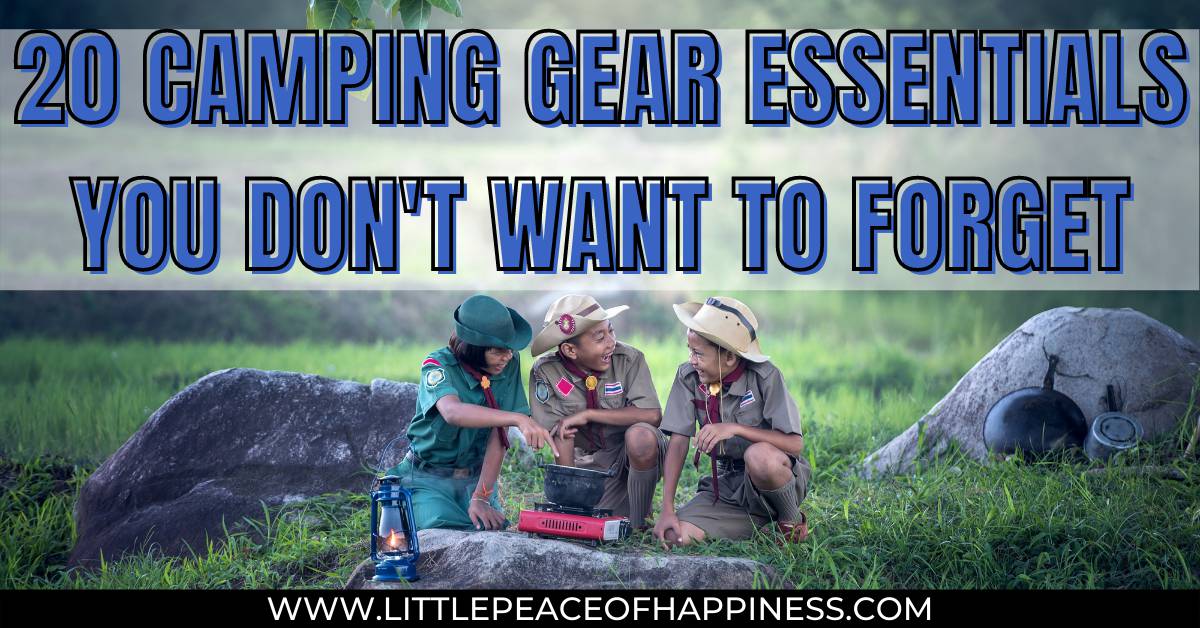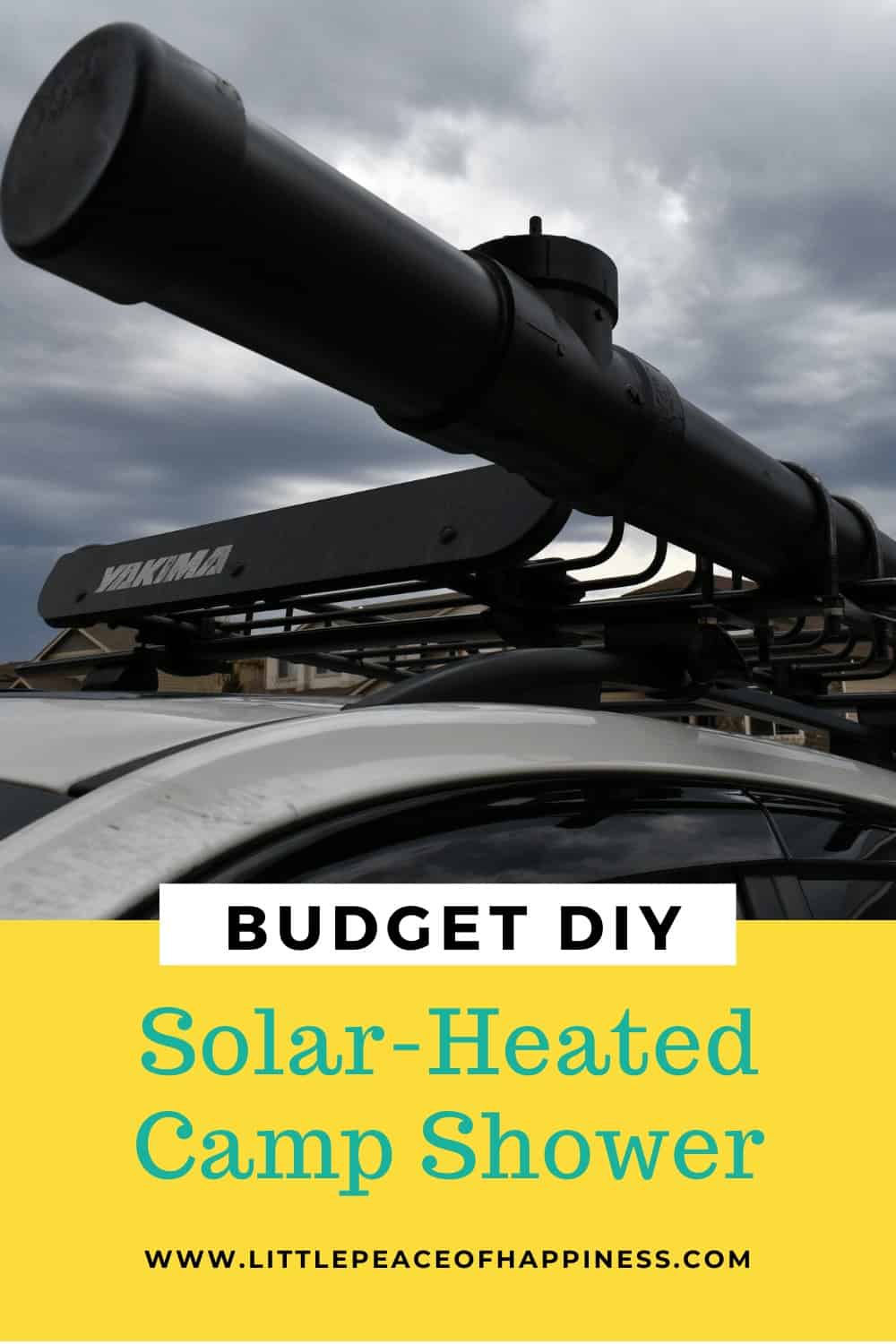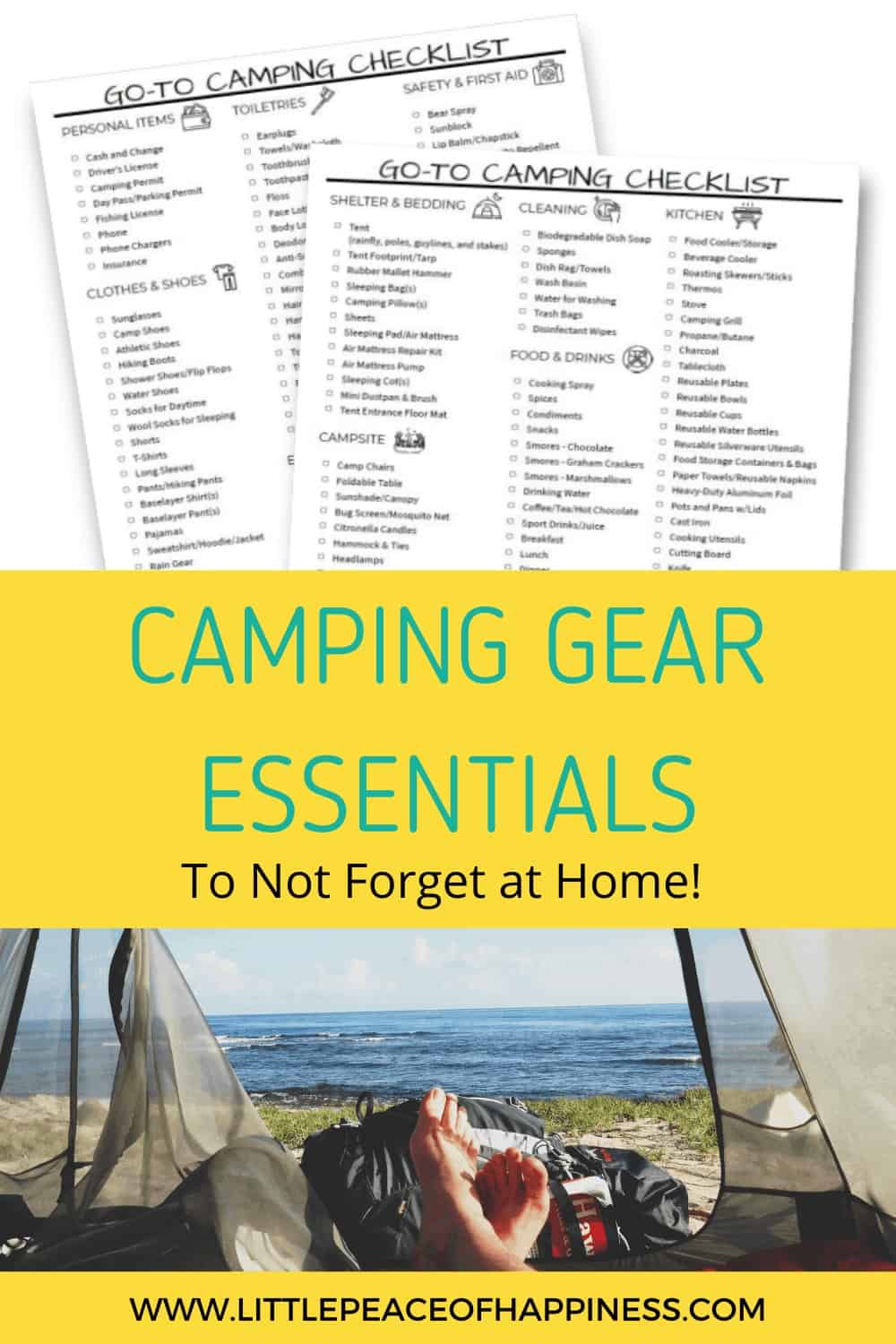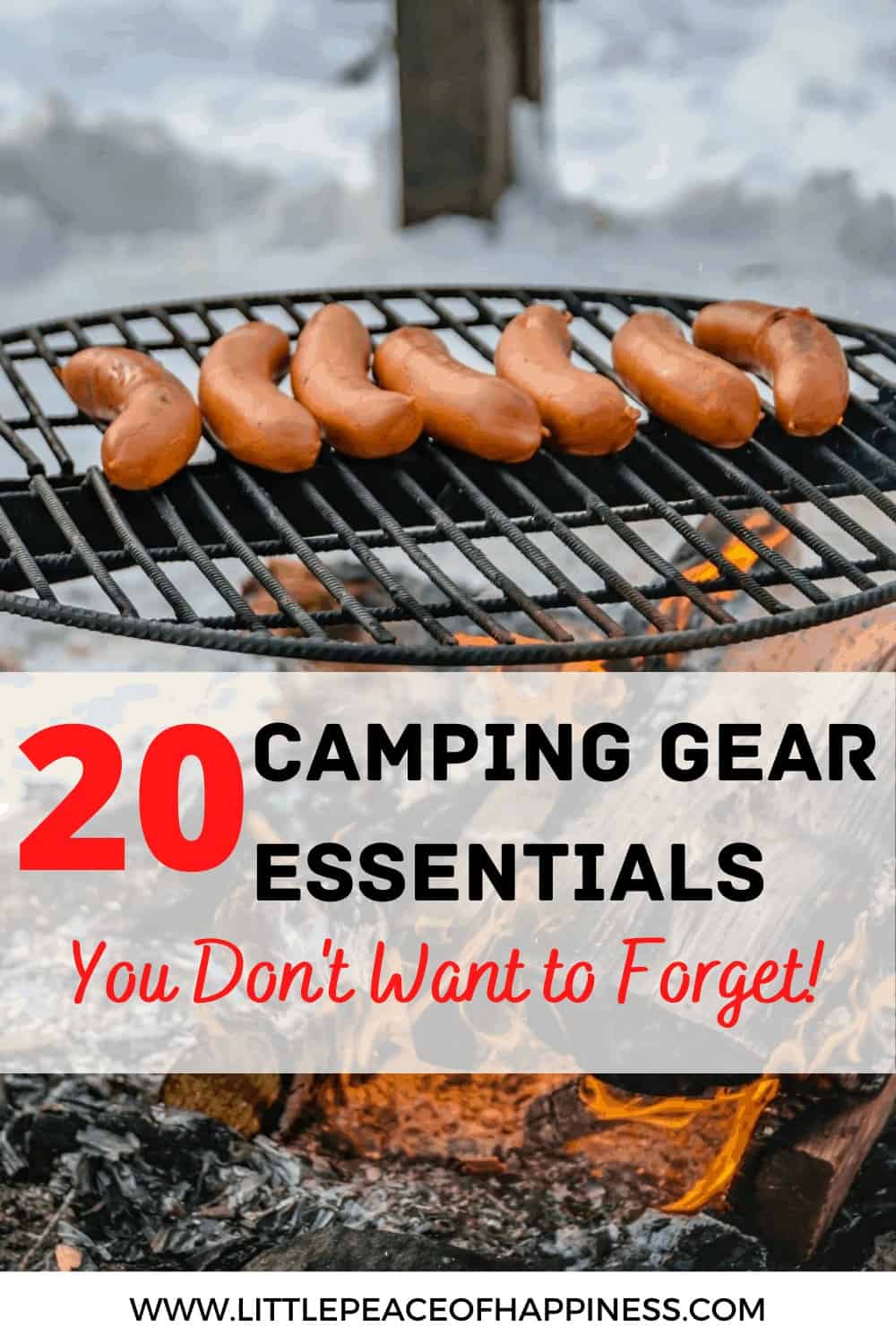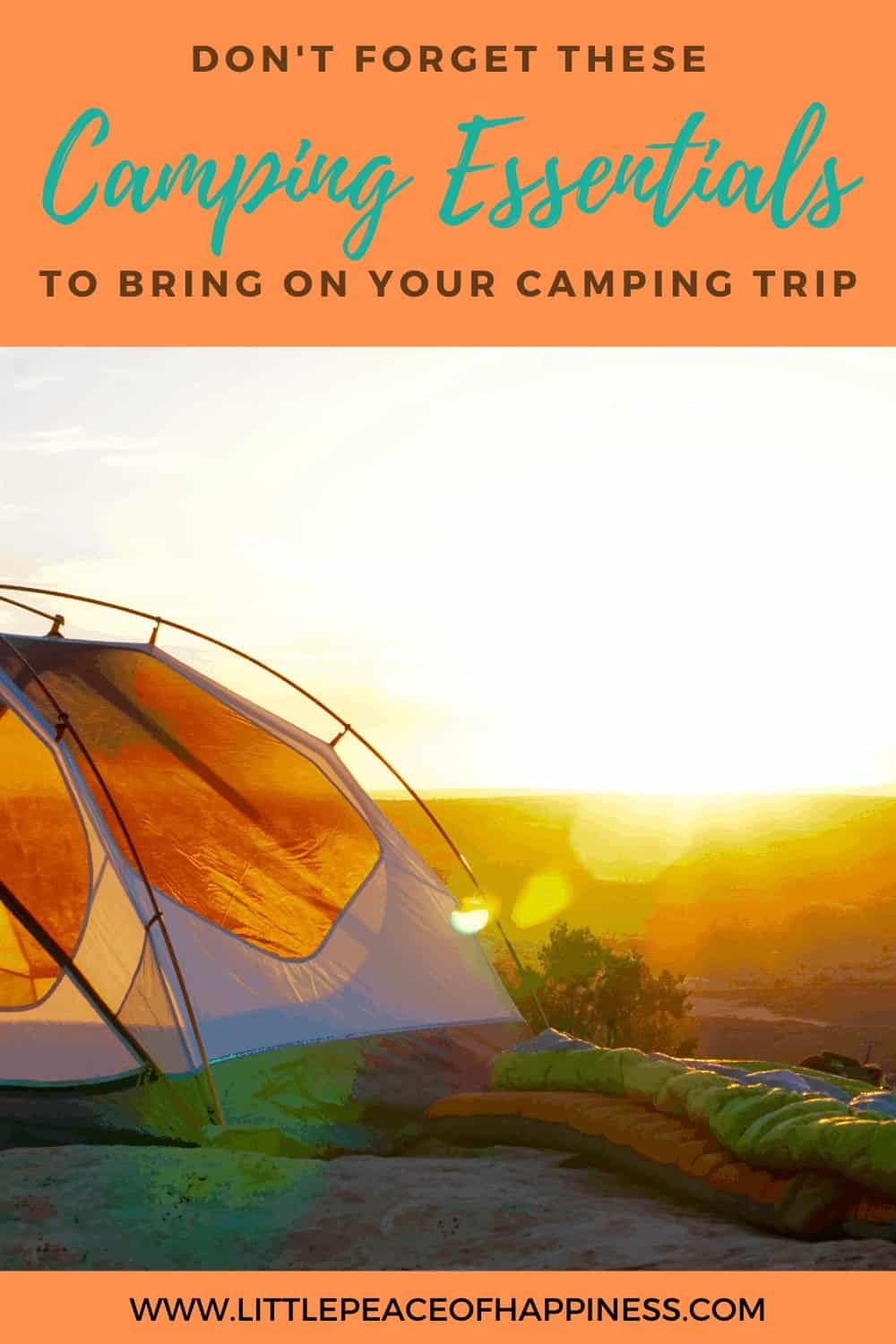Are you planning your next camping trip and you’re not sure what to bring? Are you afraid of being underprepared or maybe you might be bringing too much.
In this post, I’ll go over the camping gear essentials that we never leave home without. My list may be different from yours and may vary on your camping location, but will give you a great head start.
Preparing for a camping trip is very much like planning your weekend getaway, with the additional tasks of bringing your own equipment to get through the day
We’ve been camping regularly since 2015. Whenever we’re packing for a camping trip, we like to run through our daily routine to figure out the things that we need.
By the end of this post, you’ll discover camping gear must-haves that you’ll think twice before leaving your home.
To make your life easier, I created a printable Camping Checklist that you can use over and over again!
Some of the links in this post are affiliate links. This means if you click on the link and purchase the item, I will receive an affiliate commission at no extra cost to you. All opinions remain my own.
20 Camping Gear Essentials To Bring Camping

1. Tent & Tent Stakes
If you’re not car camping or glamping in a cabin or yurt, a tent is a must-have item.
Earlier I mentioned that there are season-rated camping gear and tents are one of them. When you’re looking for at the technical specs of a tent, consider the:
- Season rating
- Sleeping capacity (number of people)
- Peak height (the tallest point for sitting/standing)
- Areas for outside coverage (vestibule)
- Availability of a rainfly (protective tent cover over mesh areas)
Not all tents come with rainflys and those are important to protect you from the outside elements. Some rainflys are built-in, while others come as a separate fabric cover.
I suggest a tent size that will sleep 1-2 people more than the people actually using it.
This will give you enough space for you to sleep comfortably and fit all of your other essentials inside the tent (like clothes and games).
Don’t forget the tent stakes! You don’t want your tent being lifted off the ground and flying away. When you’re staking down your tent, make sure to stake every guyline and grommet!
We made the mistake of not staking two of our front guylines and when the wind came, it blew in the front of our tent and even broke one of our tent poles!
Your tent should come with the tent stakes, but we like to upgrade the manufacturer provided stakes with something thicker and more durable. We like to use heavy duty tent stakes, like this one here.
Related Posts: How to Build a Solar Shower on a Budget

2. Tent Floor Tarp or Footprint
Tent footprints are other tent components that don’t always come with the tent.
Footprints offer another level of protection to your tent floor by protecting it from sharp rocks piercing through the fabric and to keep the bottom of your tent clean from mud and dirt.
Camping guru’s suggest a footprint that is 1-2 inches smaller than your tent to avoid water being sandwiched between the tent floor and footprint.
Personally, we have used a blue tarp that was larger than our tent and the extra space in front of our tent door was a place for our shoes.
Footprints made for a specific tent can be expensive and we haven’t had any issues using a blue tarp as our footprint. If you want to DIY your own footprint, you can use:
- PU Coated Nylon Fabric – what other footprints are made of
- Tyvek Ground Cloth
- Waterproof Multipurpose, Blue Tarp

3. Sleeping Bag and Pillow
A sleeping bag is another season-rated item and can be filled with synthetic insulation, feathered down, or a hybrid of both.
Sleeping bags can come in a few different shapes. I found the most comfortable to be a rectangular shape versus a mummy shape.
If you’re a side sleeper, the rectangular offers more space around the toes and room to move. The mummy sleeping bag has its own benefits as well. Being a bit more constrictive it traps in heat better and closer to your core.
Our very first sleeping bags were synthetic insulation and went down to 25 degrees. They were bulky and hard to roll back up, but they did the trick for several years.
Now that we’ve been camping for some time, we decided to finally upgrade our sleeping bags. When we were planning for our first backpacking trip, we wanted a sleeping bag that we could use tent camping and be lightweight for backpacking.

The sleeping bag specs we were looking for was one that was under $200, less than 3 lbs, could compress down to a small size, and go down to at least 20 degrees fahrenheit.
As a budget-friendly option, I chose the Big Agnes 20 Sleeping Bag that has a semi rectangular shape and 600-fill power DownTek down. Long went with the REI Co-op Igneo 17 Sleeping Bag. Both sleeping bags were under $150 each.
However, if I wanted to splurge, I would have gone with the NEMO Disco 15 Sleeping Bag for its unique spoon shape design and Thermo Gills to vent body heat. NEMO also offers a lifetime warranty on their sleeping bags.
As for your pillow, if you’re tent, car camping, or even glamping you can just bring a pillow from home if you have the space in your car. Personally, we use rectangular travel pillows and I made an envelope pillowcase from fleece fabric.
4. Sleeping Pad
When you’re camping in a tent, laying your sleeping bag on the hard cold ground is going to make it very uncomfortable to fall asleep.
Overnight, the ground below your tent will get colder and you will feel this through your sleeping bag. You will also wake up with aching hips and back. Getting a decent night’s rest is key to enjoying your camping experience.
You can use an inflatable or foam sleeping pad to protect your body from the cold elements of the ground and to give you additional body support. These are most commonly used for backpacking as well.
Inflatable sleeping pads are made for the outdoors and come in different thickness and R-value. The higher the R-value, the warmer you will be. They can be pricey, but we found an affordable option that is also great for backpacking.
We use the KLYMIT Static V Camping Sleeping Pad. It is a budget friendly option that doesn pretty well and it advertises that it is great for side sleepers as well!
If we’re not backpacking, we like to use a regular inflatable air mattress. There are some pros and cons to this. While it will provide you more comfortable body support, the air inside the air mattress will become cold overnight.
If you decide to go with an inflatable air mattress, it’s best to make sure you cover it with another blanket to block the cold.
Another alternative is a sleeping cot, where you are elevated off of the floor entirely. You don’t have to worry about inflating anything. However, these can be big and bulky.
5. Lighting
There’s nothing more relaxing than looking up at the starry-night sky by a nice and cozy fire at night. But sometimes, you’ll need to see where you’re going when you’re camping somewhere with little light pollution.
Camp lighting comes in a few different forms and what you choose to bring, will depend on the type of camping you’re doing. In any type of light source, I suggest looking for one that has multiple light modes of brightness and also a red light.
When you’re camping at a designated campsite among other campers, it’s polite to try to use as little light as possible at night when you’re walking around. Other campers are also there to enjoy the night sky and serenity of nature.
Here are some light sources you may want to consider lightweight headlamps, a small flashlight, or even a lantern.
When we’re tent camping, we have a variety of all three types of lighting.

Headlamps are great for when you need to do your business in the woods or walk to the restroom. It’s also great to have when you’re out fishing at night.
A small flashlight is great for a quick light source. Personally, we don’t use headlamps too often, but we do have them for those moments that we want to be handsfree.
Lanterns are great if we need to prepare a meal in the dark or need to see in our tent. We have two different lanterns that we can bring.
If we’re backpacking, we prefer our solar-powered inflatable camp lantern. When we’re tent camping, we use the Cedar Smart Living LED Ceramic Lantern.
6. Water Bottles
Water is essential to life, especially when you’re outdoors exposed to the elements. If it’s a hot day out, water is going to quench your thirst the best.
Some established campsites may provide you with potable water that you can use for drinking. Whether you bring your own water or find some on-site, you’ll need a way to store it.
To reduce plastic waste and your carbon footprint, I highly recommend that you bring a reusable water bottle.
While buying individual pre-bottled water is convenient. I ALWAYS see unfinished water bottles at the end of the camping trip. No one labels their bottles and in the end, the water is wasted.
With a reusable water bottle, everyone can have their designed cup and you can bring a gallon or two of water instead if you are unable to drink the water at the campsite.
Buying 1-2 gallons of water to refill your reusable water bottle is less wasteful than the individual bottled waters.
If you plan on doing any day hikes, I recommended bringing a backpack daypack with a hydration bladder/water reservoir.
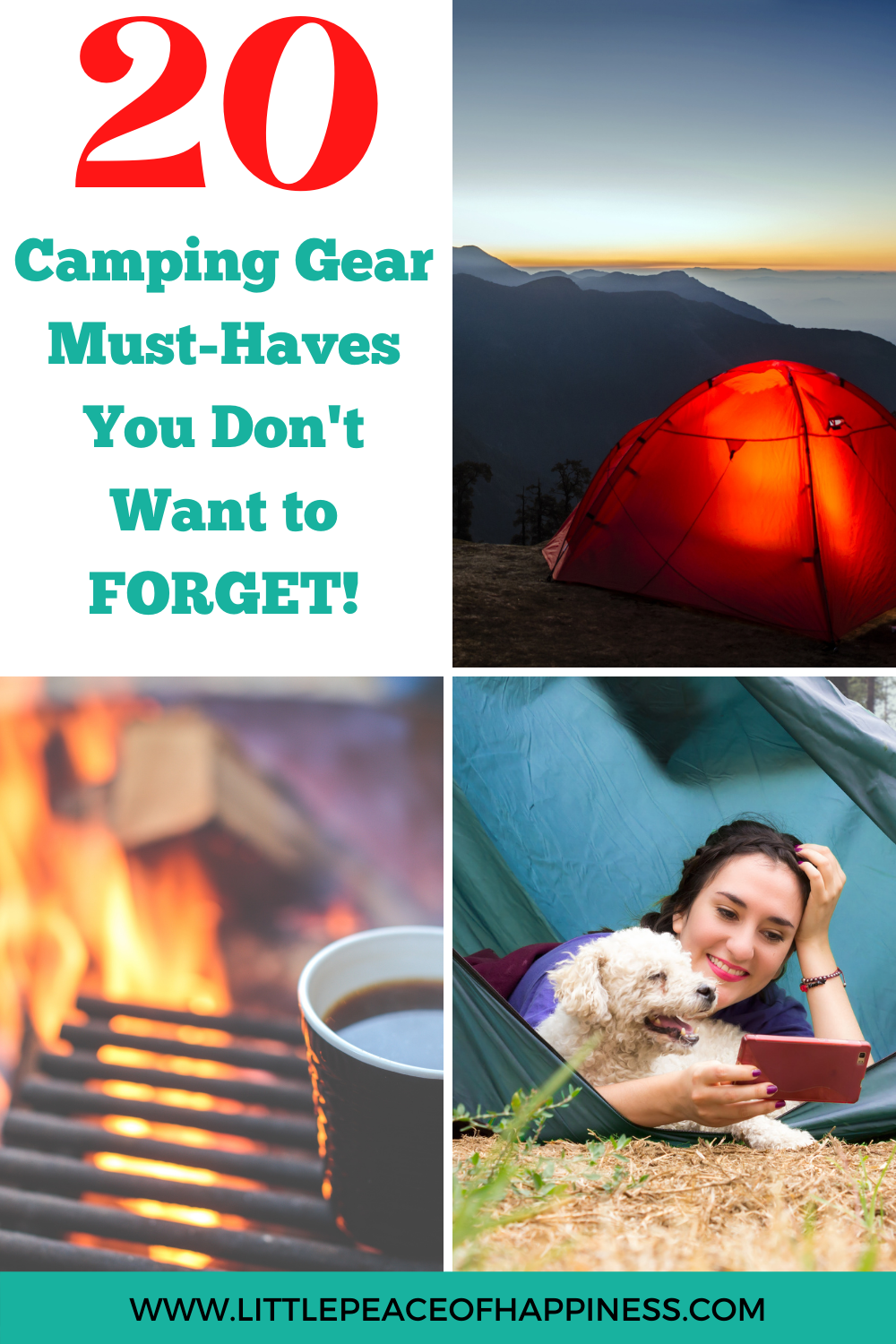
7. Drink and Food Cooler
Since you’re away from home and other amenities, you’ll need food to replenish you over the camping trip.
A drink and food cooler, can be a debatable necessity to some. Especially if you’re trying to pack light and are bringing only processed foods, then maybe you won’t need a cooler.
We always bring a cooler every time we are tent camping and even glamping. The only time we haven’t was when we were backpacking. We obviously wouldn’t want to bring a large cooler on a backpacking trip when we’re already carrying 30-50 lbs on our backs.
When you’re just tent or car camping, you can enjoy a cold drink and a fresh meal if you have a cooler.
Coolers can be big and bulky can take up a lot of space in your car. Try to use a cooler that is sized for your needs and avoid anything that is smaller or larger than that.
We use a large cooler for all our food and drinks and then a smaller 2-gallon beverage cooler that we use to wash our hands or dishes with.

8. Cookware
Depending on your campsite, it may include a firepit with a grill grate so you can cook directly on top of your fire. Or if you feel comfortable, you can even toss in your aluminum foil-wrapped meal right in the firepit.
What makes our camping trips more enjoyable is when we are able to cook the same meals that we would have at home. For that reason, we bring our own cookware so that we can boil water for our morning coffee or late-night ramen cup.
We enjoy grilled foods over the summer and the Coleman Fold N Go Propane Grill makes it nice and convenient on our camping trips.
To complement our grill, we also use a Portable Butane Stove. As big foodies, both cooking instruments make our camping meals so much more enjoyable than the dehydrated camping meals.

9. Fire Starter & Fire Wood
Lounging with friends and family around a toasty campfire is a great way to end the day and spend the evenings.
Most established campsites will provide a fire pit so you can set up your campfire. As mentioned previously, you can even make your meals in the campfire if you feel comfortable.
Setting up a campfire can be slow to start up and get a nice burn unless you have some sort of kindling, fire starter, or even some matches.
There are a few different fire starter options out there. A budget-friendly option is just to use the lint from your dryer and stuff it inside a toilet paper tube!
Depending on the campsite, you may find firewood available to purchase on site. If site regulations allow, you might be able to pick up downed wood and use that to make your campfire. Contact your campground agency to ask about the use of downed wood.
10. Eating Utensils
When you’re away from the kitchen and making meals outside, you need a way to eat your food!
Don’t forget your eating utensils. You can find reusable camping utensils online that will help you reduce your waste from using single-use plastics. These are great for on the go and you don’t ever have to worry about buying more.
If you don’t want to invest in reusable camping utensils, you can always pack a set of utensils from your kitchen drawer!

11. Biodegradable Soap
Unless you bring enough dishware to last the weekend or don’t plan to get your hands dirty, it’s a good idea to bring biodegradable dish soap.
Two popular choices from campers are CampsudsⓇ and Dr. Bronner’s All in One Unscented Castile Liquid Soap.
Both soap options are great because they are safe to use in nature because they are fully biodegradable and do not threaten the environment.
CampsudsⓇ and Dr. Bronner’s are also concentrated so a little goes a long way and can be used for multiple things. They both can be used for personal care such as washing your hands, face, clothes, and even your dishes!
12. Trash & Recycling Bags
Mother Nature belongs to us all and if we want to keep it around for years to come and share this enjoyable experience with others, we need to clean up after ourselves.
One of the 7 Principles of Leave No Trace is to dispose of waste properly. Many established campsites will provide areas to dump your trash and some even have bear-proof containers.
When you’re out camping, you most likely won’t walk to the trash bin every time you want to throw something away.
Bring 2-3 full-sized trash to collect any waste from your food scraps, drinks, and cooking. Try to separate your trash from your recycles to reduce what you add to the landfill.
Before you call it a night, make sure to remove any trash from your campsite and store it in your car overnight or take it to the provided trash receptacles.
Removing the trash from your campsite will prevent any wildlife digging through the crash and potential dangerous wildlife encounters.
Related Posts: How to Build a Solar Shower on a Budget

13. Portable Power Banks
One of the reasons you might be enjoying your time outdoors is to disconnect. You might be wondering why you need a portable power bank.
When you are out camping you might want to take pictures on your phone to capture the memories being made.
With the latest technology, our phones can also double as our GPS and serve as a form of communication in times of emergencies.
Having a reliable power source to charge up necessary electronics will come in handy. During our honeymoon to Costa Rica, our portable solar powered bank allowed us to charge our electronics when a tree fell down on the power lines.
14. Emergency First Aid Kit
You can never predict when you or a loved one could get hurt or have a bad stomach on your camping trip.
Being prepared for emergencies and moments of discomfort can be what saves you from ending your camping trip early.
You can buy a prepared emergency first aid kit to include in your camper bin or you can make your own DIY Emergency & First Aid Kit.
When you plan your trip and prepare for an emergency, think about the activities you’ll be doing and the environment.
In our first aid kit, we like to include medications to relieve pain and discomfort such as headaches, stomach issues, allergies, etc.
Our camping trips are usually in established designated campgrounds, so we opt for a more basic first aid kit with bandage adhesives, cleaning agents, tweezers, etc.
15. Bear Spray
If you’re camping out in bear country, then bear spray is an absolute must-have!
It would be great if you never have to use it, but it’s a smart idea to have it and highly recommended by many outdoor professionals and campgrounds.
Make sure to bring a full bear spray can. A partially used bear spray, may not have enough contents to deter the wildlife so you can get yourself to safety.
Follow the manufacturer’s directions and make sure that you and all parties understand how to use the bear spray. Have it on you or nearby for accessibility at all times.
Having bear spray and using it when you have to is the difference between life and death.
16. Mosquito Repellent
Camping out in the natural elements means that you’ll be dealing with bugs. Yup, it’s a given that is unavoidable.
Having an insect and mosquito repellent of some kind, will make your camping trip more enjoyable.
There are many different formulas of repellants as well as different methods. A repellant with DEET is very common in aerosol repellents.
More natural sprays that are DEET-free will use eucalyptus such as this one from REPEL.
Candles and scent-throwing methods of repellant will have citronella. Whatever method you prefer, be prepared with some type of insect repellent if you want to avoid going home with bite marks and scratching.
Just in case, pack an anti-itch cream such as one with cortisone.
17. GPS or Map and Compass
Camping in nature often means you’ll be away from phone towers and cell phone reception. Having a handheld GPS Navigator can help you find your way out of dense forests if you’re doing any dispersed camping.
Thankfully, we’ve been able to get away with just using our cell phones for GPS.
Even though we may not have cell or internet reception when we camp, we can still access out GPS maps by downloading them before we leave the house.
Our Google Maps phone app, allows us to download maps that can be used offline. This means that we can route directions on the map and look up anything that is in the area that we downloaded.
Downloading a GoogleMap for offline use will have to be done before you leave for your trip since it needs to be downloaded over the internet.
If you really want to go light weight, you can learn how to use a map and compass.
18. Toilet Paper
Many established and designated campsites will provide toilet paper in the restrooms. But imagine when all the toilet paper runs out.
I am thankful for the park rangers for taking care of the campgrounds and patrolling the area to make sure we’re all having a great time. With everything our park rangers have to do, they might not get to restocking right away.
Sometimes the restrooms won’t be cleaned or restocked until the following morning or even every other day depending on how busy it can be.
In times like these, using your emergency toilet paper stash comes in handy. It can also help you out when your behind is feeling raw from the single-ply toilet paper.
The toilet paper can also be challenging to get off the roll with the holders they have in place. When you get to a campground with restrooms, you’ll know what I’m talking about.
19. Camping Tools
It takes preparation if you want to have a successful and enjoyable camping trip. Having at least these camping tools can make your life just a little bit easier.

- Rubber Mallet or Hammer: for hammering in the tent stakes. Some tent mallets even have a tool at the end of it to help you remove the stakes from the ground.
- Axe: for cutting up firewood that you bring or any downed wood that you find.
- Multifunctional Multitool Pocket Knife/Pliers: I think this one is self-explanatory. This will come in handy for a variety of things when you’re out camping.
- Pad/Mattress Repair Kit: Just in case your sleeping pad or air mattress catches onto a sharp rock and punctures your “bed”. This can prevent you from sleeping on the hard ground.
- Paracord Rope/String: Such as a paracord is one of the suggested items from camping and survival gurus. You can use it as an extra tie down for your tent, to hang dry some laundry, keep your fish together in the water, etc.

20. Something You Enjoy
Unless you plan to just sit there, immersed in your thoughts to become one with the nature around you, you may want to consider bringing something you enjoy doing.
When we camp, if the weather is favorable we like to hike. On our hikes, we bring trekking poles to save you joints from aches and pains.
Along the hikes, I like to take photos of the landscape and any wildlife we encounter so I bring my Nikon 7500D.
If you’re a bird watcher, you may want to bring a pair of binoculars such as the Nikon Prostaff 3S 10×42 Binoculars. It’s the same binoculars we purchased and used for our honeymoon in Costa Rica.
If you’re looking for a more relaxing experience, maybe you want to bring your favorite book.
We all find joy in different things, so bring whatever will enhance your experience while you’re relaxing in the great outdoors!
Conclusion
Camping offers a great nature experience and getaway from the stresses of work and life in general. Being outdoors provides a positive benefit for mental, emotion, and physical health by disconnecting from our noisy world.
When I created this list, I thought about all the things that we wouldn’t want to forget. With these 20 camping gear essentials, you will have a more enjoyable camping experience.
By no means is this an exhaustive list because what makes your camping trip enjoyable can be different from what makes mines enjoyable.
I created a full printable camping checklist that you can download below that has more than just my suggested 20 items. This checklist will keep you organized and less stressed as you prepare for your camping trip.
Related Posts: How to Build a Solar Shower on a Budget
Wishing you a Little Peace of Happiness in your next camping adventure!

Pin Me for Later!

